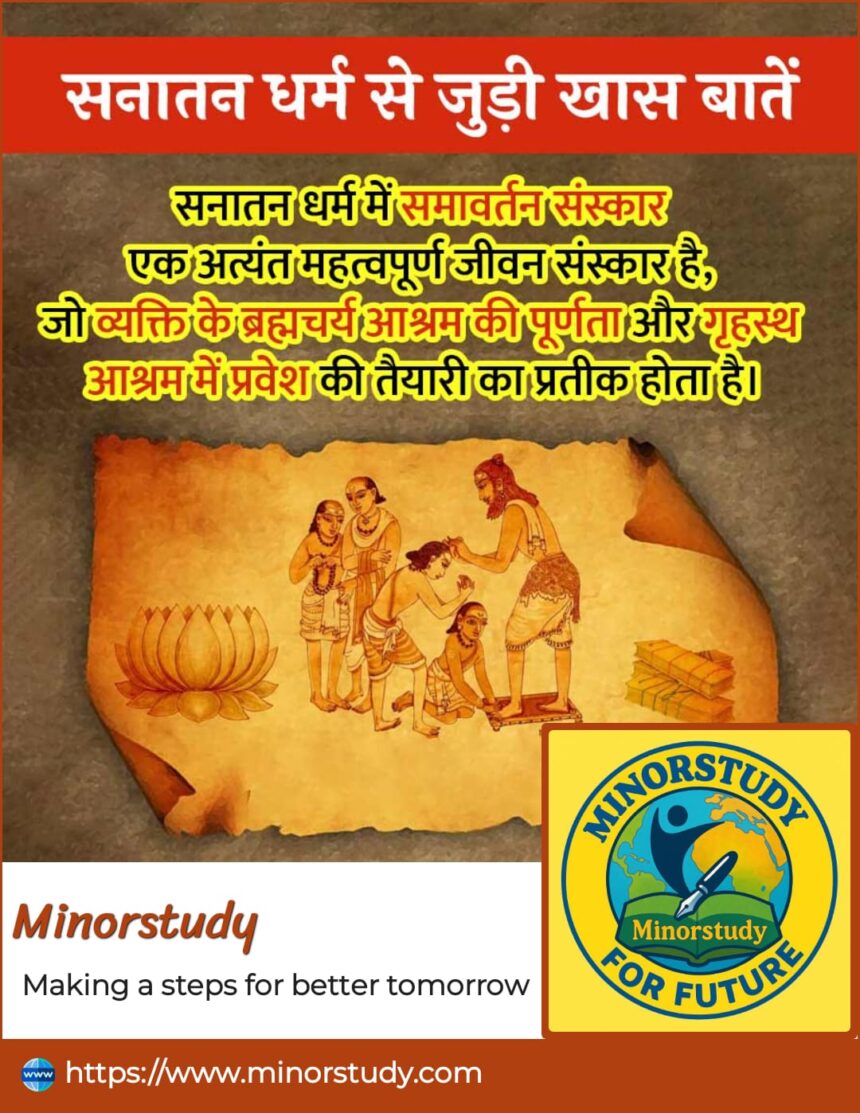🕉️ Introduction: Samavartan Sanskar – A Journey from Student to Householder
Sanatan Dharma (Eternal Way), the world’s most ancient and spiritual tradition, is rooted in a profound understanding of human life and its evolutionary stages. Among its 16 sacred sanskars (rites of passage), Samavartan Sanskar holds a transformational and celebratory position.
- 🕉️ Introduction: Samavartan Sanskar – A Journey from Student to Householder
- 📚 History of Samavartan Sanskar in Sanatan Dharma
- 🧠 7 Sacred and Surprising Facts About Samavartan Sanskar
- 📅 Timeline of Samavartan Sanskar in Ancient Life
- 🔍 Frequently Asked Questions (FAQs)
- ❓What does “Samavartan” mean?
- ❓When is it performed?
- ❓Is Samavartan only for boys?
- ❓Is it necessary before marriage?
- ❓What is the significance of the “Guru-Dakshina”?
- 🌟 Significance in Our Lives Today
- 🌍 Social and Cultural Importance
- 🎊 Wishing and Celebrating Samavartan
- 📌 Important Points Summary
- 🌱 Impact on Daily Life
- 🏁 Conclusion: Samavartan – A Timeless Ritual of Life’s True Graduation
This sacred ritual signifies the end of the Brahmacharya Ashram (student phase) and the preparation for the Grihastha Ashram (householder phase). It is much more than a graduation ceremony—it is a symbol of maturity, discipline, spiritual insight, and readiness for worldly responsibilities.
Let us explore the history, significance, facts, FAQs, and modern-day relevance of this soul-enriching ritual in detail.
📚 History of Samavartan Sanskar in Sanatan Dharma
The concept of Ashram Dharma divides human life into four phases:
Brahmacharya (student life)
Grihastha (householder life)
Vanaprastha (retired life)
Sannyasa (renunciate life)
The Samavartan Sanskar marks the end of Brahmacharya—typically performed after a student has completed their Vedic education under the guidance of a Guru.
Ancient Roots:
Described in the Dharmashastras, Smritis, and Grihya Sutras, this sanskar was originally conducted with great ceremony, including ritual bathing, chanting of mantras, and Guru-Dakshina.
In Taittiriya Upanishad, the Guru gives the final sermon:
“Satyam vada, Dharmam char…” (Speak the truth, follow dharma…)
🧠 7 Sacred and Surprising Facts About Samavartan Sanskar
It’s the Only Sanskar That Signals Graduation in Dharma
Unlike modern convocation ceremonies, Samavartan is a soulful celebration—signifying not just academic learning but moral, spiritual, and social readiness.Guru-Dakshina is a Key Element
Students express gratitude to the Guru through Dakshina, which is not necessarily money but a heartfelt offering or promise.The Sacred Bath Is Symbolic
The ritual bath (Snana) represents cleansing of ego and ignorance, entering life anew with humility and knowledge.The Final Sermon is Universal Wisdom
Ancient Gurus gave teachings like:Be respectful to your mother, father, teacher, and guest.
Speak the truth. Uphold Dharma.
Do not abandon learning throughout life.
Bridges the Spiritual and Practical
Samavartan prepares an individual to balance Dharma and Artha, spiritual and material duties—a perfect training for Grihastha Ashram.It’s a Prerequisite to Marriage
One cannot traditionally marry (Vivah Sanskar) without undergoing Samavartan, as it affirms maturity and readiness for responsibility.Still Practiced in Gurukulas and Spiritual Paths
Many Ved Pathshalas, traditional Gurukuls, and even ISKCON centers perform this sanskar for committed students of Dharma and Vedas.
📅 Timeline of Samavartan Sanskar in Ancient Life
| Age Range | Ashram | Key Ritual |
|---|---|---|
| 5–8 yrs | Vidyarambha | Learning begins |
| 8–25 yrs | Brahmacharya | Vedic learning phase |
| ~25 yrs | Samavartan Sanskar | Transition to Grihastha |
| 25–50 yrs | Grihastha | Marriage, career, family life |
| 50–75 yrs | Vanaprastha | Spiritual retreat |
| 75+ yrs | Sannyasa | Renunciation and Moksha pursuit |
🔍 Frequently Asked Questions (FAQs)
❓What does “Samavartan” mean?
✅ “Samavartan” means “returning home”—specifically from the Guru’s Ashram after completing Vedic education.
❓When is it performed?
✅ Typically around the age of 25, after the student completes his Brahmacharya stage.
❓Is Samavartan only for boys?
✅ Traditionally, it was mostly for boys. However, in modern times, girls undergoing Vedic education in Gurukuls may also celebrate it.
❓Is it necessary before marriage?
✅ According to tradition, yes. Samavartan marks readiness for the Grihastha Ashram, which includes marriage and family life.
❓What is the significance of the “Guru-Dakshina”?
✅ It symbolizes gratitude and humility, a reminder that learning is a gift from the Guru, not a transactional service.
🌟 Significance in Our Lives Today
Even if not performed formally, the philosophy behind Samavartan Sanskar offers timeless guidance:
Knowledge is a sacred responsibility, not just a means to earn.
Teachers must be respected and cherished.
Truth, Dharma, and service are the foundations of a meaningful life.
Spiritual learning is never truly “complete”—Samavartan is the start of application, not the end of education.
In a world obsessed with degrees and grades, this sanskar reminds us of values, ethics, and holistic growth.
🌍 Social and Cultural Importance
Community Bonds: The ritual often involves community gatherings, reinforcing social unity.
Preserving Traditions: Helps pass on Vedic knowledge and cultural values.
Role of the Guru: Reinforces the sacred Guru-Shishya Parampara, which is core to Indian civilization.
Preparing Future Leaders: The qualities inculcated—self-discipline, humility, dharma—are foundational for good citizens.
🎊 Wishing and Celebrating Samavartan
“Wishing all seekers of Sanatan Dharma a meaningful and blessed Samavartan! May your knowledge guide you to righteousness and bliss.” 🕉️
“As you leave the Gurukul and step into the world, may truth, compassion, and Dharma be your companions forever.”
“The Samavartan Sanskar is not the end—it’s a sacred beginning. May your journey into Grihastha Ashram be full of wisdom and joy.”
📌 Important Points Summary
Samavartan is the 11th Sanskar of the 16 Samskaras in Sanatan Dharma.
Marks the end of Brahmacharya Ashram and prepares for Grihastha Ashram.
Key components: Snana (ritual bath), Guru-Dakshina, Final Teachings, and blessings.
Promotes spiritual maturity, moral clarity, and social responsibility.
Its values are eternally relevant—whether you’re in ancient Bharat or modern India.
🌱 Impact on Daily Life
Even in modern times, Samavartan Sanskar can inspire personal growth:
🎓 Post-graduation reflection: It’s a time to ask—What kind of human will I be?
🙏 Respect for mentors: Honoring your teacher becomes a life practice.
⚖️ Balanced life: Embracing both material goals and spiritual awareness.
💡 Moral compass: Embeds ethics and service as lifelong companions.
🌺 Cultural connection: Revives pride in Sanatan traditions.
🏁 Conclusion: Samavartan – A Timeless Ritual of Life’s True Graduation
In an age where external achievements are celebrated more than inner development, Samavartan Sanskar emerges as a deeply positive reminder of what real education and growth mean.
It is not just a “passing out” ceremony but a stepping into responsibility with spiritual maturity, social awareness, and cultural pride.
In the eternal rhythm of Sanatan Dharma, Samavartan is not a farewell—
It is the auspicious beginning of a life well-lived. 🌼
Let us honor this sacred tradition, whether through rituals or reflection, and pass it forward to the next generation—so that truth, dharma, and humility never go extinct.









войти в 1с через облако 1с облако
Новости Украины https://gromrady.org.ua в реальном времени. Экономика, политика, общество, культура, происшествия и спорт. Всё самое важное и интересное на одном портале.
оценка нма оценочная компания
лампа косметолога стул косметолога со спинкой купить
swot анализ оценки swot анализ пример
Want to have fun? porno bangladesh melbet Watch porn, buy heroin or ecstasy. Pick up whores or buy marijuana. Come in, we’re waiting
Новые актуальные промокод на скидку iherb для выгодных покупок! Скидки на витамины, БАДы, косметику и товары для здоровья. Экономьте до 30% на заказах, используйте проверенные купоны и наслаждайтесь выгодным шопингом.
займ онлайн займы на карту онлайн мгновенно без отказа
взять займ онлайн без мгновенно онлайн займ срочно
plug in prague cocain in prague from peru
buy cocaine prague cocaine in prague
prague drugs cocain in prague from columbia
plug in prague plug in prague
Нужна лабораторная? https://lab-ucheb.ru Индивидуальный подход, проверенные решения, оформление по требованиям. Доступные цены и быстрая помощь.
Нужен чертеж? https://chertezhi-kurs.ru выполним чертежи для студентов на заказ. Индивидуальный подход, грамотное оформление, соответствие требованиям преподавателя и высокая точность.
Нужна презентация? заказать презентацию Красочный дизайн, структурированный материал, уникальное оформление и быстрые сроки выполнения.
buy cocaine prague buy coke in prague
cocaine prague telegram cocaine in prague
Нужна презентация? презентация через нейросеть бесплатно Создавайте убедительные презентации за минуты. Умный генератор формирует структуру, дизайн и иллюстрации из вашего текста. Библиотека шаблонов, фирстиль, графики, экспорт PPTX/PDF, совместная работа и комментарии — всё в одном сервисе.
значки на заказ со своей картинкой значки свой дизайн на заказ
значок на пиджак изготовление заказ на изготовление значков
melbet – paris sportif pronostic foot gratuit